stop start DODGE MAGNUM SRT 2007 1.G Owner's Manual
[x] Cancel search | Manufacturer: DODGE, Model Year: 2007, Model line: MAGNUM SRT, Model: DODGE MAGNUM SRT 2007 1.GPages: 380, PDF Size: 6.63 MB
Page 224 of 380
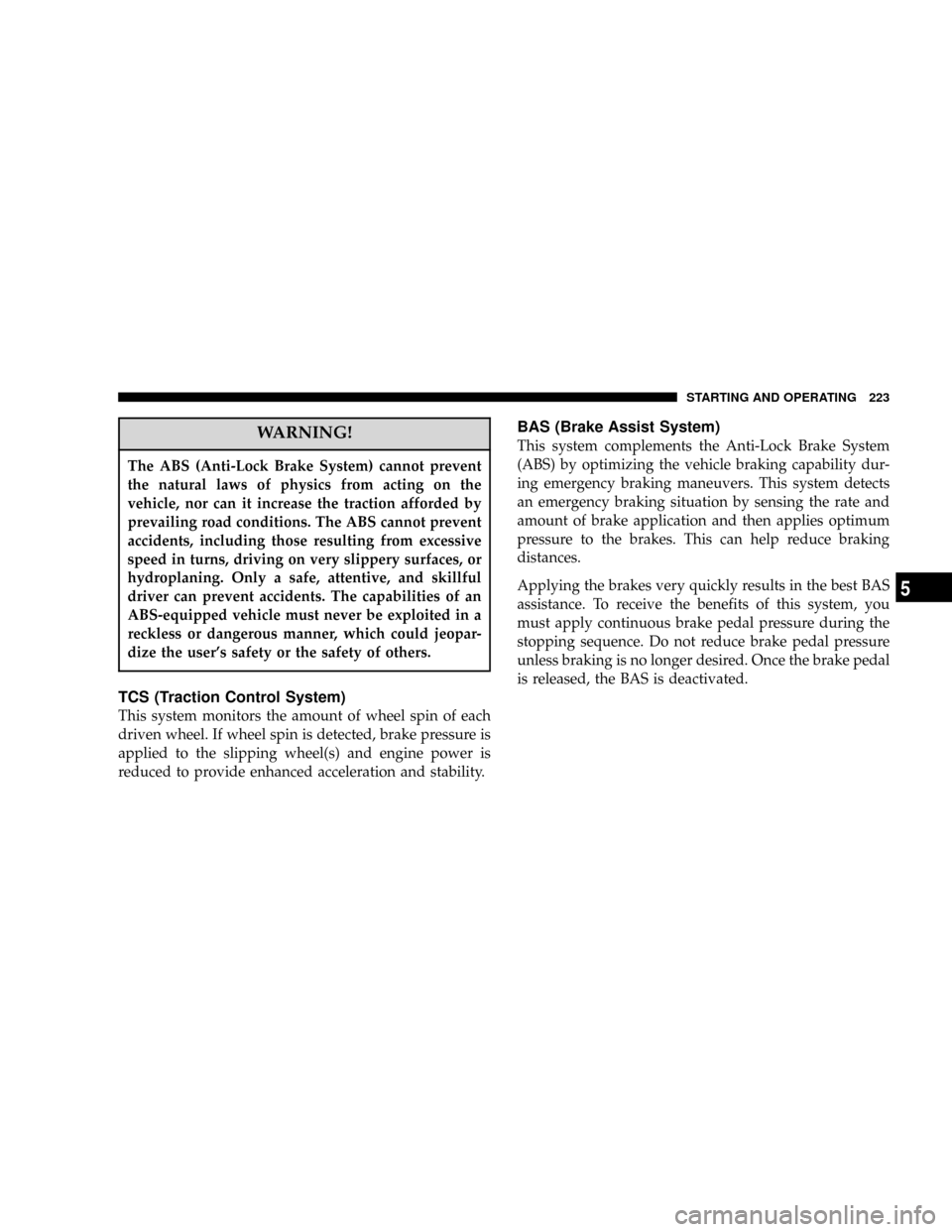
WARNING!
The ABS (Anti-Lock Brake System) cannot prevent
the natural laws of physics from acting on the
vehicle, nor can it increase the traction afforded by
prevailing road conditions. The ABS cannot prevent
accidents, including those resulting from excessive
speed in turns, driving on very slippery surfaces, or
hydroplaning. Only a safe, attentive, and skillful
driver can prevent accidents. The capabilities of an
ABS-equipped vehicle must never be exploited in a
reckless or dangerous manner, which could jeopar-
dize the user's safety or the safety of others.
TCS (Traction Control System)
This system monitors the amount of wheel spin of each
driven wheel. If wheel spin is detected, brake pressure is
applied to the slipping wheel(s) and engine power is
reduced to provide enhanced acceleration and stability.
BAS (Brake Assist System)
This system complements the Anti-Lock Brake System
(ABS) by optimizing the vehicle braking capability dur-
ing emergency braking maneuvers. This system detects
an emergency braking situation by sensing the rate and
amount of brake application and then applies optimum
pressure to the brakes. This can help reduce braking
distances.
Applying the brakes very quickly results in the best BAS
assistance. To receive the benefits of this system, you
must apply continuous brake pedal pressure during the
stopping sequence. Do not reduce brake pedal pressure
unless braking is no longer desired. Once the brake pedal
is released, the BAS is deactivated.
STARTING AND OPERATING 223
5
Page 227 of 380
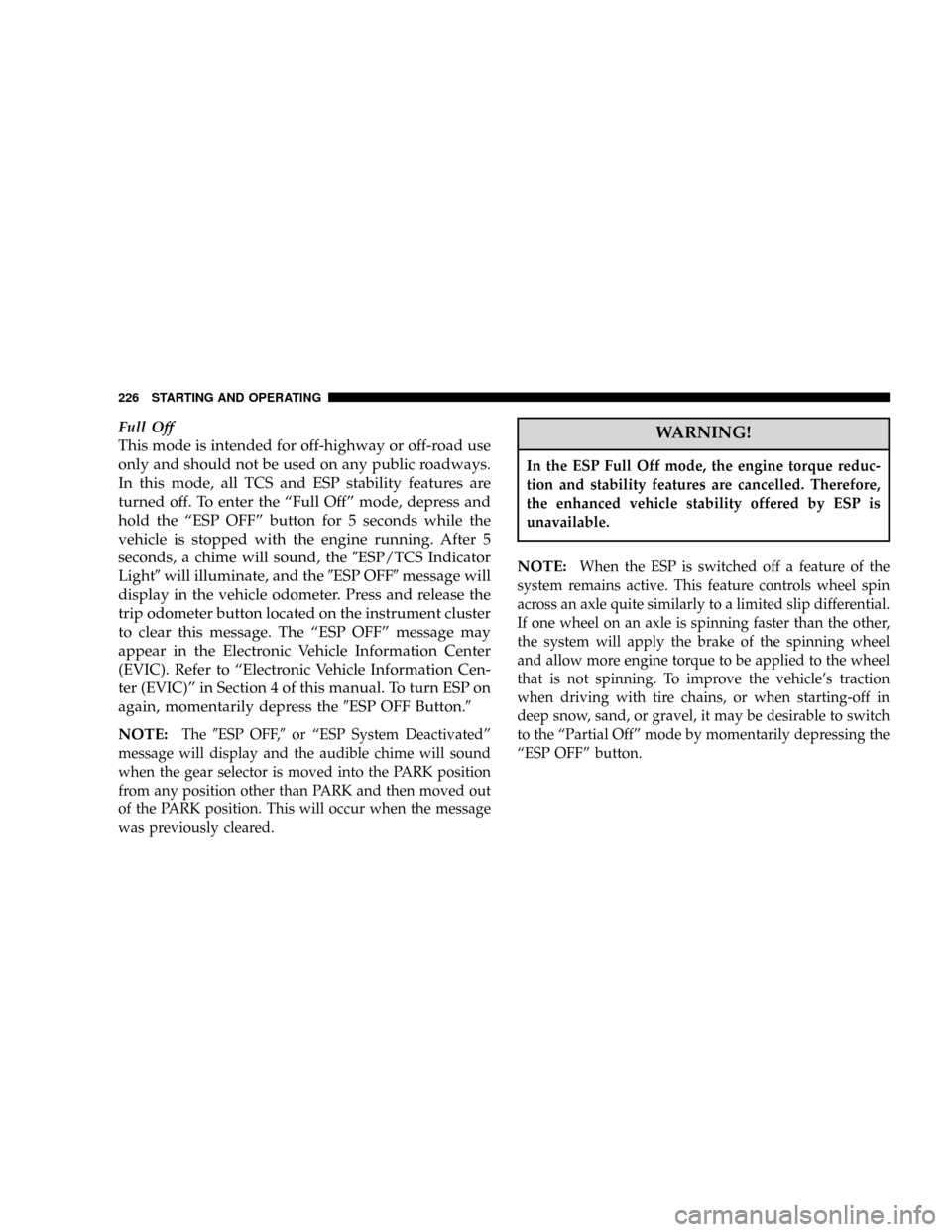
Full Off
This mode is intended for off-highway or off-road use
only and should not be used on any public roadways.
In this mode, all TCS and ESP stability features are
turned off. To enter the ªFull Offº mode, depress and
hold the ªESP OFFº button for 5 seconds while the
vehicle is stopped with the engine running. After 5
seconds, a chime will sound, the9ESP/TCS Indicator
Light9will illuminate, and the9ESP OFF9message will
display in the vehicle odometer. Press and release the
trip odometer button located on the instrument cluster
to clear this message. The ªESP OFFº message may
appear in the Electronic Vehicle Information Center
(EVIC). Refer to ªElectronic Vehicle Information Cen-
ter (EVIC)º in Section 4 of this manual. To turn ESP on
again, momentarily depress the9ESP OFF Button.9
NOTE:
The9ESP OFF,9or ªESP System Deactivatedº
message will display and the audible chime will sound
when the gear selector is moved into the PARK position
from any position other than PARK and then moved out
of the PARK position. This will occur when the message
was previously cleared.
WARNING!
In the ESP Full Off mode, the engine torque reduc-
tion and stability features are cancelled. Therefore,
the enhanced vehicle stability offered by ESP is
unavailable.
NOTE:When the ESP is switched off a feature of the
system remains active. This feature controls wheel spin
across an axle quite similarly to a limited slip differential.
If one wheel on an axle is spinning faster than the other,
the system will apply the brake of the spinning wheel
and allow more engine torque to be applied to the wheel
that is not spinning. To improve the vehicle's traction
when driving with tire chains, or when starting-off in
deep snow, sand, or gravel, it may be desirable to switch
to the ªPartial Offº mode by momentarily depressing the
ªESP OFFº button.
226 STARTING AND OPERATING
Page 229 of 380
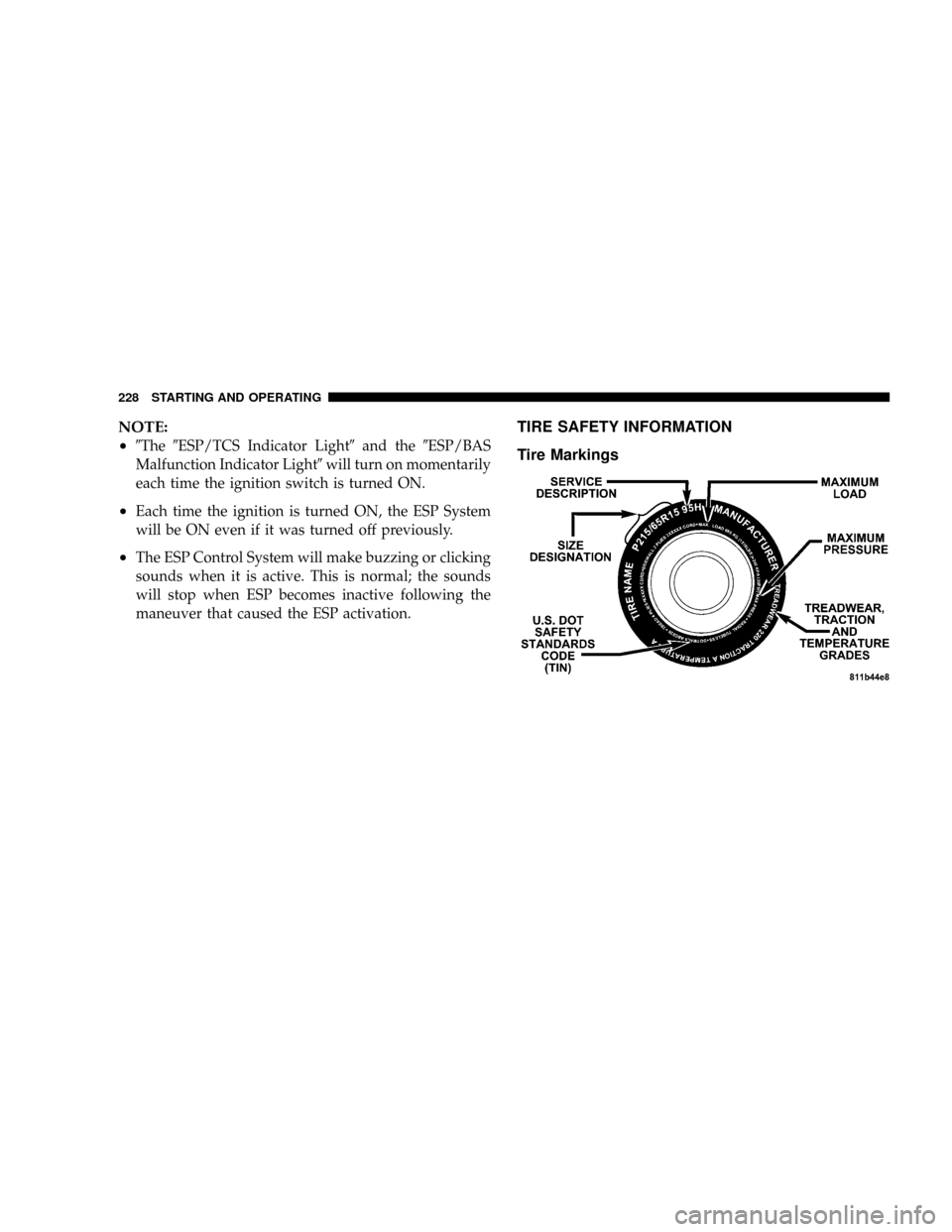
NOTE:
²
9The9ESP/TCS Indicator Light9and the9ESP/BAS
Malfunction Indicator Light9will turn on momentarily
each time the ignition switch is turned ON.
²Each time the ignition is turned ON, the ESP System
will be ON even if it was turned off previously.
²The ESP Control System will make buzzing or clicking
sounds when it is active. This is normal; the sounds
will stop when ESP becomes inactive following the
maneuver that caused the ESP activation.
TIRE SAFETY INFORMATION
Tire Markings
228 STARTING AND OPERATING
Page 238 of 380
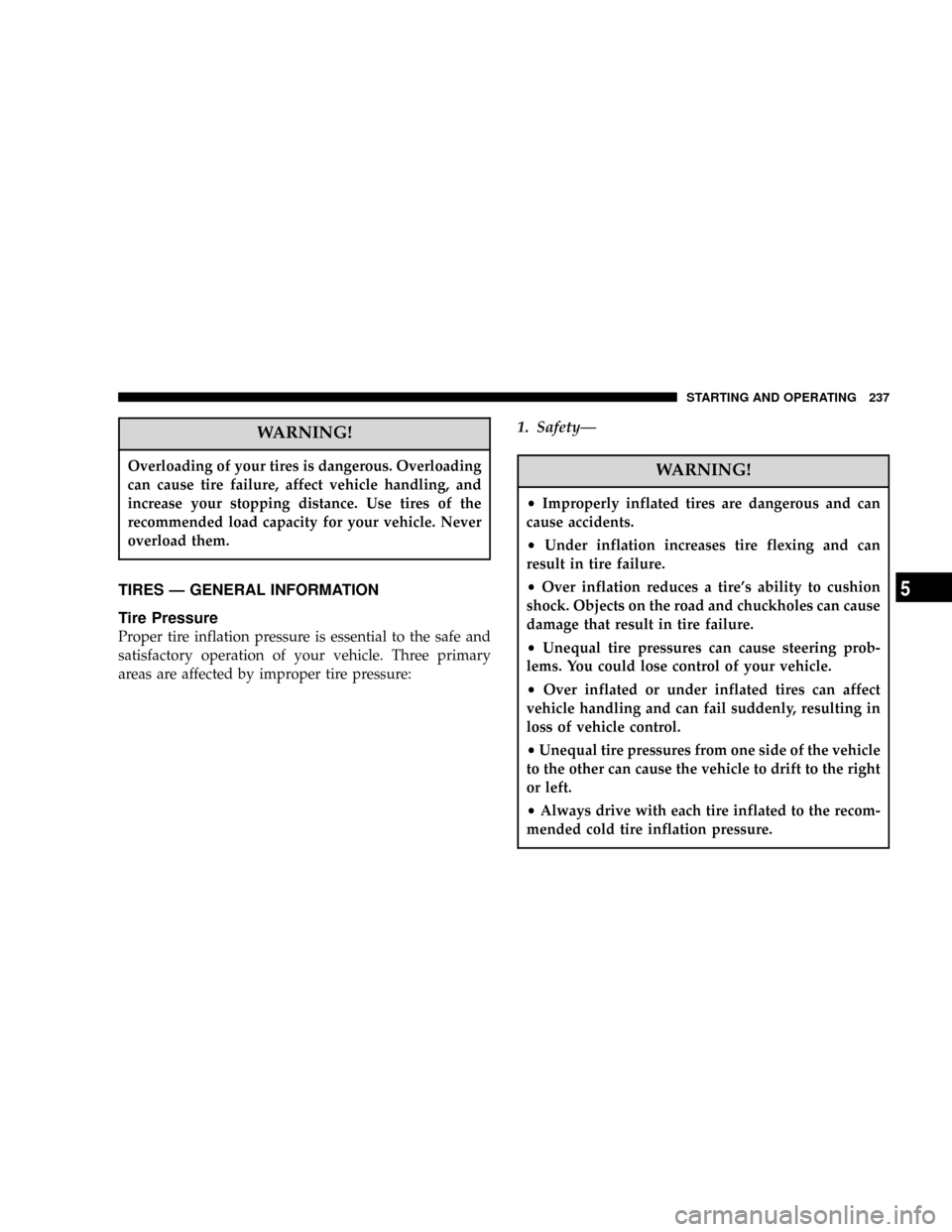
WARNING!
Overloading of your tires is dangerous. Overloading
can cause tire failure, affect vehicle handling, and
increase your stopping distance. Use tires of the
recommended load capacity for your vehicle. Never
overload them.
TIRES Ð GENERAL INFORMATION
Tire Pressure
Proper tire inflation pressure is essential to the safe and
satisfactory operation of your vehicle. Three primary
areas are affected by improper tire pressure:
1. SafetyÐ
WARNING!
²Improperly inflated tires are dangerous and can
cause accidents.
²Under inflation increases tire flexing and can
result in tire failure.
²Over inflation reduces a tire's ability to cushion
shock. Objects on the road and chuckholes can cause
damage that result in tire failure.
²Unequal tire pressures can cause steering prob-
lems. You could lose control of your vehicle.
²Over inflated or under inflated tires can affect
vehicle handling and can fail suddenly, resulting in
loss of vehicle control.
²Unequal tire pressures from one side of the vehicle
to the other can cause the vehicle to drift to the right
or left.
²Always drive with each tire inflated to the recom-
mended cold tire inflation pressure.
STARTING AND OPERATING 237
5
Page 245 of 380
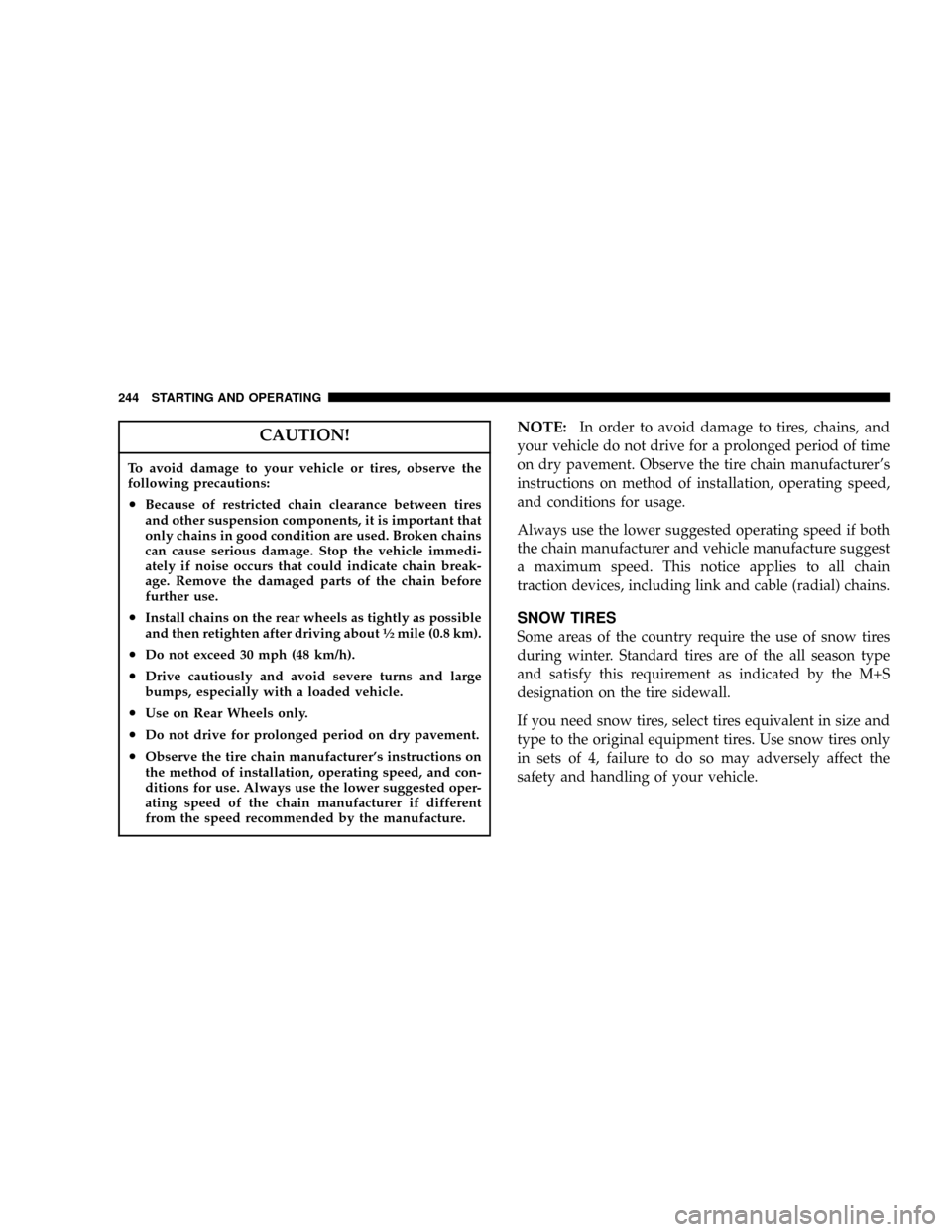
CAUTION!
To avoid damage to your vehicle or tires, observe the
following precautions:
²Because of restricted chain clearance between tires
and other suspension components, it is important that
only chains in good condition are used. Broken chains
can cause serious damage. Stop the vehicle immedi-
ately if noise occurs that could indicate chain break-
age. Remove the damaged parts of the chain before
further use.
²Install chains on the rear wheels as tightly as possible
and then retighten after driving about1¤2mile (0.8 km).
²Do not exceed 30 mph (48 km/h).
²Drive cautiously and avoid severe turns and large
bumps, especially with a loaded vehicle.
²Use on Rear Wheels only.
²Do not drive for prolonged period on dry pavement.
²Observe the tire chain manufacturer's instructions on
the method of installation, operating speed, and con-
ditions for use. Always use the lower suggested oper-
ating speed of the chain manufacturer if different
from the speed recommended by the manufacture.
NOTE:In order to avoid damage to tires, chains, and
your vehicle do not drive for a prolonged period of time
on dry pavement. Observe the tire chain manufacturer's
instructions on method of installation, operating speed,
and conditions for usage.
Always use the lower suggested operating speed if both
the chain manufacturer and vehicle manufacture suggest
a maximum speed. This notice applies to all chain
traction devices, including link and cable (radial) chains.
SNOW TIRES
Some areas of the country require the use of snow tires
during winter. Standard tires are of the all season type
and satisfy this requirement as indicated by the M+S
designation on the tire sidewall.
If you need snow tires, select tires equivalent in size and
type to the original equipment tires. Use snow tires only
in sets of 4, failure to do so may adversely affect the
safety and handling of your vehicle.
244 STARTING AND OPERATING
Page 249 of 380
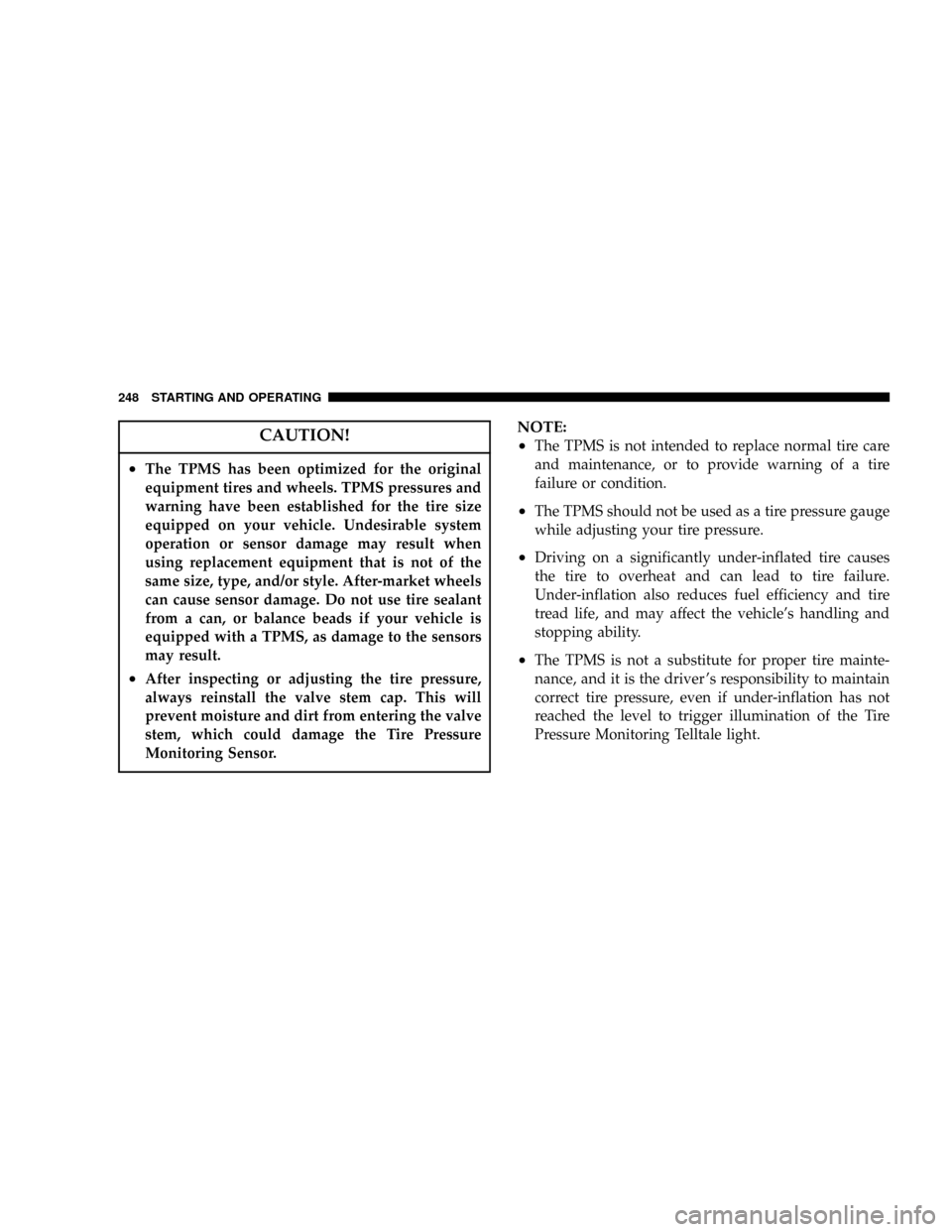
CAUTION!
²The TPMS has been optimized for the original
equipment tires and wheels. TPMS pressures and
warning have been established for the tire size
equipped on your vehicle. Undesirable system
operation or sensor damage may result when
using replacement equipment that is not of the
same size, type, and/or style. After-market wheels
can cause sensor damage. Do not use tire sealant
from a can, or balance beads if your vehicle is
equipped with a TPMS, as damage to the sensors
may result.
²After inspecting or adjusting the tire pressure,
always reinstall the valve stem cap. This will
prevent moisture and dirt from entering the valve
stem, which could damage the Tire Pressure
Monitoring Sensor.
NOTE:
²
The TPMS is not intended to replace normal tire care
and maintenance, or to provide warning of a tire
failure or condition.
²The TPMS should not be used as a tire pressure gauge
while adjusting your tire pressure.
²Driving on a significantly under-inflated tire causes
the tire to overheat and can lead to tire failure.
Under-inflation also reduces fuel efficiency and tire
tread life, and may affect the vehicle's handling and
stopping ability.
²The TPMS is not a substitute for proper tire mainte-
nance, and it is the driver 's responsibility to maintain
correct tire pressure, even if under-inflation has not
reached the level to trigger illumination of the Tire
Pressure Monitoring Telltale light.
248 STARTING AND OPERATING
Page 250 of 380
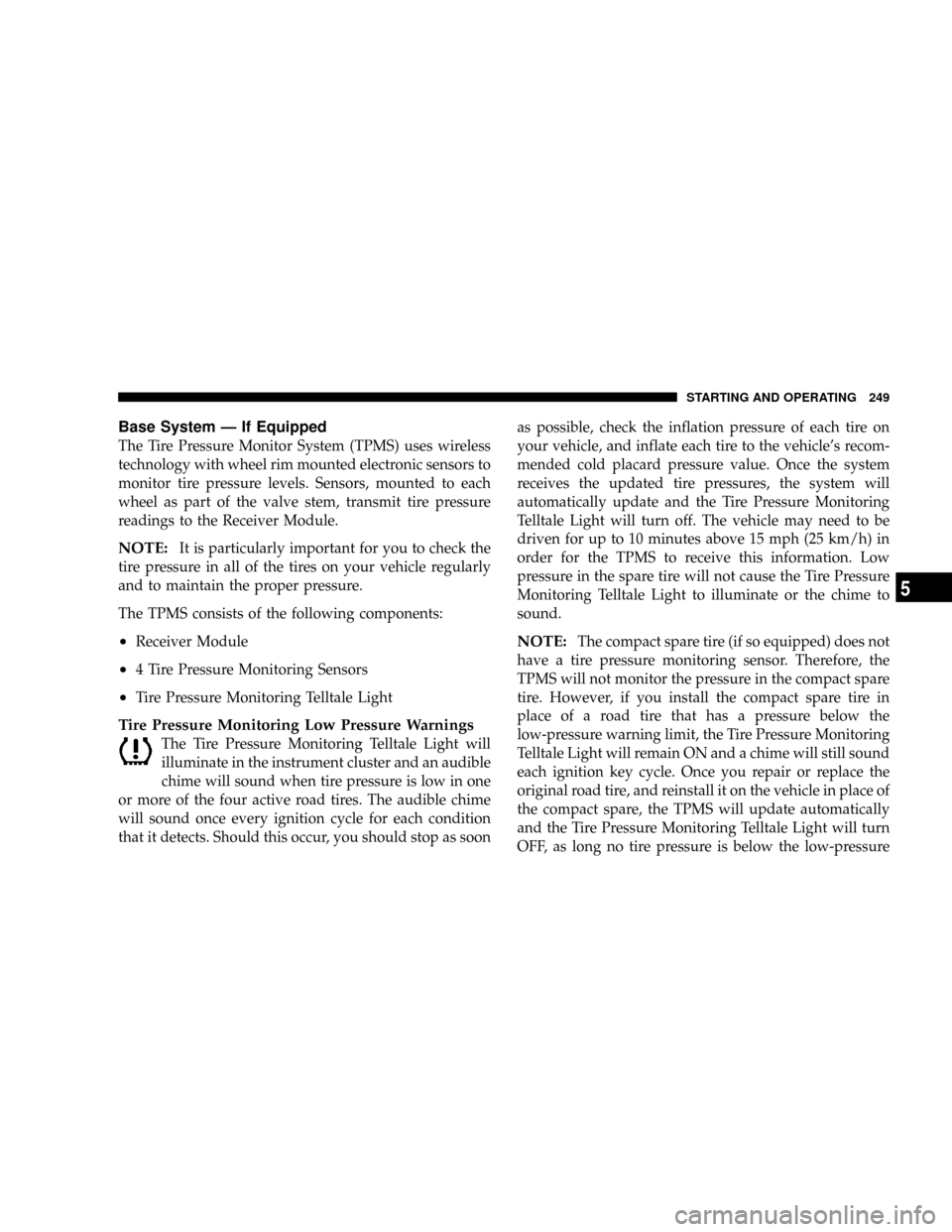
Base System Ð If Equipped
The Tire Pressure Monitor System (TPMS) uses wireless
technology with wheel rim mounted electronic sensors to
monitor tire pressure levels. Sensors, mounted to each
wheel as part of the valve stem, transmit tire pressure
readings to the Receiver Module.
NOTE:It is particularly important for you to check the
tire pressure in all of the tires on your vehicle regularly
and to maintain the proper pressure.
The TPMS consists of the following components:
²Receiver Module
²4 Tire Pressure Monitoring Sensors
²Tire Pressure Monitoring Telltale Light
Tire Pressure Monitoring Low Pressure Warnings
The Tire Pressure Monitoring Telltale Light will
illuminate in the instrument cluster and an audible
chime will sound when tire pressure is low in one
or more of the four active road tires. The audible chime
will sound once every ignition cycle for each condition
that it detects. Should this occur, you should stop as soonas possible, check the inflation pressure of each tire on
your vehicle, and inflate each tire to the vehicle's recom-
mended cold placard pressure value. Once the system
receives the updated tire pressures, the system will
automatically update and the Tire Pressure Monitoring
Telltale Light will turn off. The vehicle may need to be
driven for up to 10 minutes above 15 mph (25 km/h) in
order for the TPMS to receive this information. Low
pressure in the spare tire will not cause the Tire Pressure
Monitoring Telltale Light to illuminate or the chime to
sound.
NOTE:The compact spare tire (if so equipped) does not
have a tire pressure monitoring sensor. Therefore, the
TPMS will not monitor the pressure in the compact spare
tire. However, if you install the compact spare tire in
place of a road tire that has a pressure below the
low-pressure warning limit, the Tire Pressure Monitoring
Telltale Light will remain ON and a chime will still sound
each ignition key cycle. Once you repair or replace the
original road tire, and reinstall it on the vehicle in place of
the compact spare, the TPMS will update automatically
and the Tire Pressure Monitoring Telltale Light will turn
OFF, as long no tire pressure is below the low-pressure
STARTING AND OPERATING 249
5
Page 252 of 380
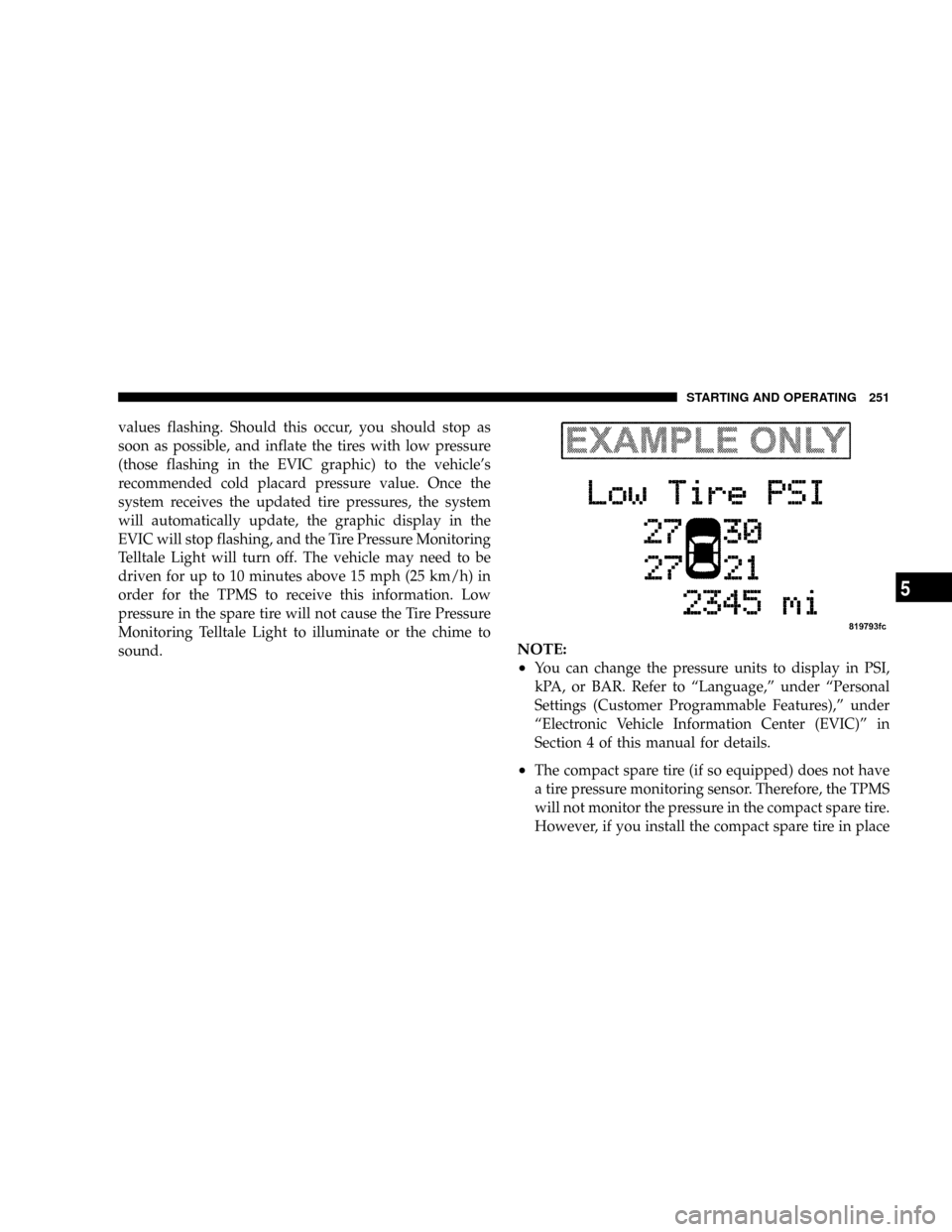
values flashing. Should this occur, you should stop as
soon as possible, and inflate the tires with low pressure
(those flashing in the EVIC graphic) to the vehicle's
recommended cold placard pressure value. Once the
system receives the updated tire pressures, the system
will automatically update, the graphic display in the
EVIC will stop flashing, and the Tire Pressure Monitoring
Telltale Light will turn off. The vehicle may need to be
driven for up to 10 minutes above 15 mph (25 km/h) in
order for the TPMS to receive this information. Low
pressure in the spare tire will not cause the Tire Pressure
Monitoring Telltale Light to illuminate or the chime to
sound.
NOTE:
²
You can change the pressure units to display in PSI,
kPA, or BAR. Refer to ªLanguage,º under ªPersonal
Settings (Customer Programmable Features),º under
ªElectronic Vehicle Information Center (EVIC)º in
Section 4 of this manual for details.
²The compact spare tire (if so equipped) does not have
a tire pressure monitoring sensor. Therefore, the TPMS
will not monitor the pressure in the compact spare tire.
However, if you install the compact spare tire in place
STARTING AND OPERATING 251
5
Page 253 of 380
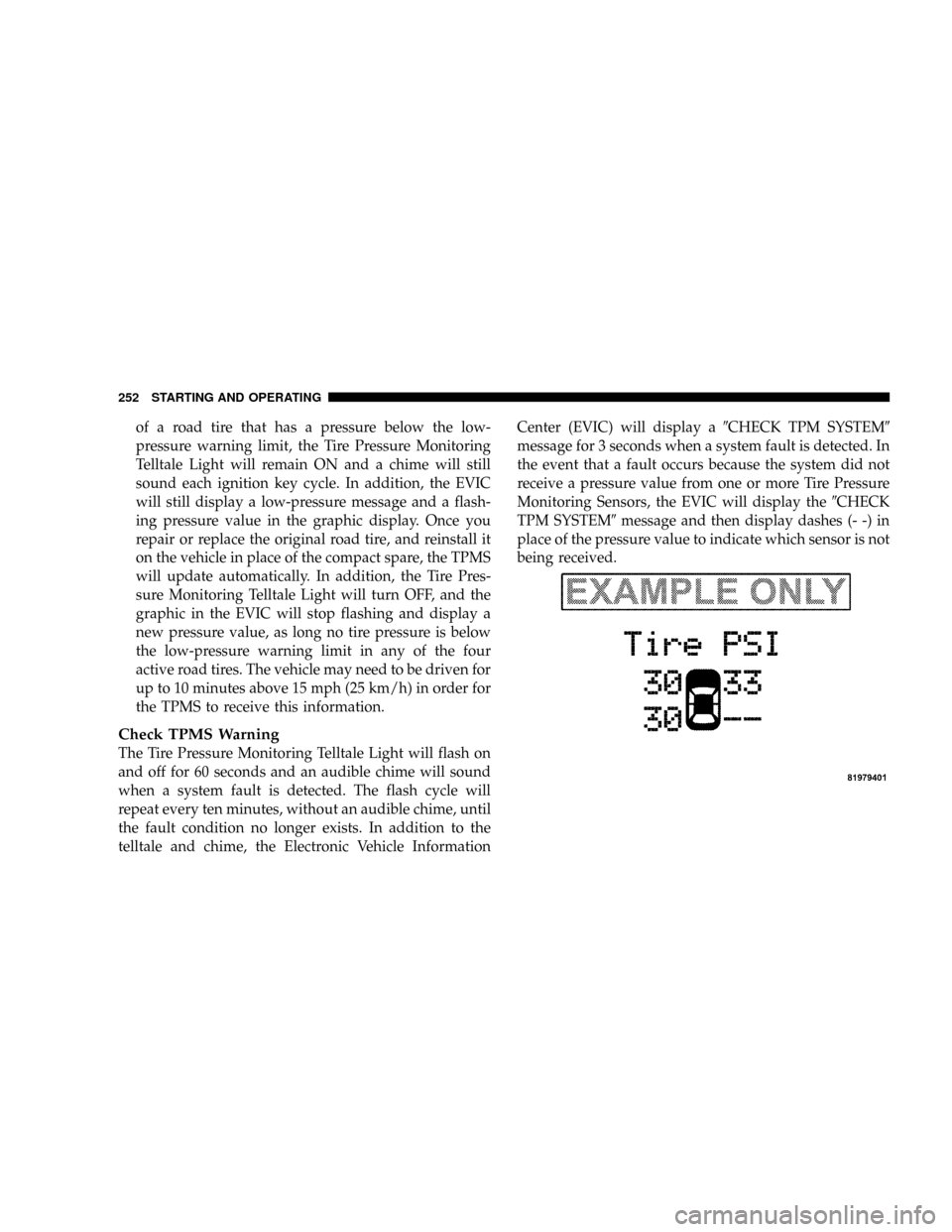
of a road tire that has a pressure below the low-
pressure warning limit, the Tire Pressure Monitoring
Telltale Light will remain ON and a chime will still
sound each ignition key cycle. In addition, the EVIC
will still display a low-pressure message and a flash-
ing pressure value in the graphic display. Once you
repair or replace the original road tire, and reinstall it
on the vehicle in place of the compact spare, the TPMS
will update automatically. In addition, the Tire Pres-
sure Monitoring Telltale Light will turn OFF, and the
graphic in the EVIC will stop flashing and display a
new pressure value, as long no tire pressure is below
the low-pressure warning limit in any of the four
active road tires. The vehicle may need to be driven for
up to 10 minutes above 15 mph (25 km/h) in order for
the TPMS to receive this information.
Check TPMS Warning
The Tire Pressure Monitoring Telltale Light will flash on
and off for 60 seconds and an audible chime will sound
when a system fault is detected. The flash cycle will
repeat every ten minutes, without an audible chime, until
the fault condition no longer exists. In addition to the
telltale and chime, the Electronic Vehicle InformationCenter (EVIC) will display a9CHECK TPM SYSTEM9
message for 3 seconds when a system fault is detected. In
the event that a fault occurs because the system did not
receive a pressure value from one or more Tire Pressure
Monitoring Sensors, the EVIC will display the9CHECK
TPM SYSTEM9message and then display dashes (- -) in
place of the pressure value to indicate which sensor is not
being received.
252 STARTING AND OPERATING
Page 257 of 380

²The use of fuel additives, which are now being sold as
octane enhancers, are not recommended. Most of these
products contain high concentrations of methanol.
Fuel system damage or vehicle performance problems
resulting from the use of such fuels or additives are not
the responsibility of the manufacturer.
NOTE:Intentional tampering with emissions control
systems can result in civil penalties being assessed
against you.
Carbon Monoxide Warnings
WARNING!
Carbon monoxide (CO) in exhaust gases is deadly.
Follow the precautions below to prevent carbon
monoxide poisoning:
²Do not inhale exhaust gases. They contain carbon
monoxide, a colorless and odorless gas, which can kill.
Never run the engine in a closed area, such as a
garage, and never sit in a parked vehicle with the
engine running for an extended period. If the vehicle is
stopped in an open area with the engine running for
more than a short period, adjust the ventilation system
to force fresh, outside air into the vehicle.
²Guard against carbon monoxide with proper mainte-
nance. Have the exhaust system inspected every time
the vehicle is raised. Have any abnormal conditions
repaired promptly. Until repaired, drive with all side
windows fully open.
²Keep the trunk closed when driving your vehicle to
prevent carbon monoxide and other poisonous ex-
haust gases from entering the vehicle.
256 STARTING AND OPERATING